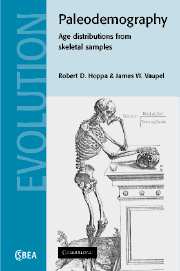Book contents
- Frontmatter
- Contents
- List of contributors
- Acknowledgments
- 1 The Rostock Manifesto for paleodemography: the way from stage to age
- 2 Paleodemography: looking back and thinking ahead
- 3 Reference samples: the first step in linking biology and age in the human skeleton
- 4 Aging through the ages: historical perspectives on age indicator methods
- 5 Transition analysis: a new method for estimating age from skeletons
- 6 Age estimation by tooth cementum annulation: perspectives of a new validation study
- 7 Mortality models for paleodemography
- 8 Linking age-at-death distributions and ancient population dynamics: a case study
- 9 A solution to the problem of obtaining a mortality schedule for paleodemographic data
- 10 Estimating age-at-death distributions from skeletal samples: a multivariate latent-trait approach
- 11 Markov chain Monte Carlo estimation of hazard model parameters in paleodemography
- 12 A re-examination of the age-at-death distribution of Indian Knoll
- Index
5 - Transition analysis: a new method for estimating age from skeletons
Published online by Cambridge University Press: 28 August 2009
- Frontmatter
- Contents
- List of contributors
- Acknowledgments
- 1 The Rostock Manifesto for paleodemography: the way from stage to age
- 2 Paleodemography: looking back and thinking ahead
- 3 Reference samples: the first step in linking biology and age in the human skeleton
- 4 Aging through the ages: historical perspectives on age indicator methods
- 5 Transition analysis: a new method for estimating age from skeletons
- 6 Age estimation by tooth cementum annulation: perspectives of a new validation study
- 7 Mortality models for paleodemography
- 8 Linking age-at-death distributions and ancient population dynamics: a case study
- 9 A solution to the problem of obtaining a mortality schedule for paleodemographic data
- 10 Estimating age-at-death distributions from skeletal samples: a multivariate latent-trait approach
- 11 Markov chain Monte Carlo estimation of hazard model parameters in paleodemography
- 12 A re-examination of the age-at-death distribution of Indian Knoll
- Index
Summary
Introduction
Estimating the ages of skeletons is an essential part of any osteologist's job, regardless of whether the skeletons come from forensic or archaeological contexts. The ages of juvenile skeletons can usually be estimated with minimal bias and an acceptable range of error, although even this endeavor is not entirely free from problems. But the situation is far worse when one is dealing with the skeletons of adults. Here a number of serious osteological and statistical problems plague the process of estimating an individual's age-at-death (see Bocquet-Appel and Masset 1982; Boldsen 1988; Masset 1989; Jackes 1992, 2000; Konigsberg and Frankenberg 1992, 1994; Milner et al. 2000). Among these difficulties is the tendency of age estimates to mimic the structure of the known-age reference samples used as standards of calibration (a problem often called “age mimicry”) and an inability to estimate the ages of older skeletons (those greater than about 50 years of age).
The Rostock protocol outlined in the present volume represents a step toward a solution of these problems. In particular, the strategy of estimating the entire age-at-death distribution f(a) before trying to estimate the age of any individual skeleton is an important, if at first somewhat counterintuitive, innovation. However, the strategy has one serious practical shortcoming: the target population has to be large enough to provide good estimates of f(a). Many archaeological skeletal samples examined by paleodemographers are simply too few in number to proceed in this manner.
- Type
- Chapter
- Information
- PaleodemographyAge Distributions from Skeletal Samples, pp. 73 - 106Publisher: Cambridge University PressPrint publication year: 2002
- 290
- Cited by

